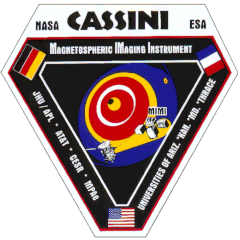Cassini MIMI Investigation at Fundamental Technologies
Historical MIMI Memos and Notes
Another Iteration of Passbands for MIMI/LEMMS 180 Degree End
(Communication from T. P. Armstrong dated 1/15/93)
TO: E. Kirsch, B. Wilken, S. Livi (MPAE); D. Mitchell, S. Krimigis, S. Jaskulek (APL)
On December 10 I received a fax from E. Kirsch containing a proposed revision of the thresholds, absorbers, and logic for the subject design. I have run range-energy calculations for representative species, hydrogen, helium, and oxygen for 1 to 1000 MeV/nucleon. Included is a summary of the parameters used. I hope that I got them translated in to the program correctly. I have assumed nominal values for noise widths and solid angle of 22.5 degrees (half cone angle).

Individual Thresholds for Design Purposes

Figure 1 shows the proton responses. My values for the lowest proton channel (I called it P1, 7.31 to 7.9 MeV) turned out somewhat narrower than Erhard's (7 to 8.9 MeV). I have checked my logic, thicknesses and thresholds and have found an explanation for this. It would appear to me that to broaden this channel by lowering the lower threshold would require using a thinner foil (taken here to be 100 microns of aluminum). P2 appears to be too broad by a factor of 2. Why not revise the logic to narrow it? A single change might broaden P1 and narrow P2. I am confused as to the purpose of P4 and P5. These channels will only respond very deep in the Saturnian magnetosphere--probably within the orbit of MIMAS. Were these channels nested on purpose? P5 will also probably respond to relativistic electrons--this should be checked. The channel labeled XX is one that was identified as responding to x-rays. It does not appear to respond to ions. PAMY, regrettably, has never known about electrons, so I have run electrons. Note that the alpha and medium channels do not respond to protons. Figure 2 shows the responses of this same channel set to alphas. Note that the channels A2 and A3 don't respond. Have I made a mistake here? Or is there a difficulty with the logic? Note that the medium channel (M1) does not respond to alphas. Figure 3 shows the response of this channel set to oxygen. Note that there is M1 response. A2 and A3 do respond to oxygen but the proton channels don't. Figure 4 shows the response of the next channel set to protons. Note that the medium channels are clean. The singles channels respond as one would expect. Protons aren't a problem in the electron channels except for a sliver of response in E5. The topmost frame shows some information that I included for design purposes--namely, the D11 threshold efficiency. Figure 5 shows the response of this channel set to alphas. Notice that the M channels are still clean. There is no evident problem here. Figure 6 shows the response of this channel set to oxygen. Note that the M channel responds nicely to oxygen. There are no obvious problems here. Figure 7 shows the proton responses of the individual threshold used in the logic. This information is valuable for design purposes. It also lets one interpret the logical functions in the channel definitions and evaluate what function causes what characteristic of the channel efficiency. Figures 8 and 9 show the alpha and oxygen responses for these individual thresholds.
(Reply from E. Kirsch)
Dear Thomas,
I thank you for the calculation of the energy channels for LEMMS. In order to extend the proton channel P1, I propose to introduce a new discriminator D2p=8.0 MeV. (The present discriminator D22-2.0 MeV is needed for the electron channels.) Thus please replace in the logic for P1 and P2 the discriminator D22 by D2p=8.0 MeV. The discriminator C12 in channel P5 should be increased to C12=0.4 MeV in order to reduce the upper limit of channel P5. (We could also drop the whole channel P5.)
I do not know what happened with the alpha channels. The lower threshold 7.31 MeV of A1 is the penetration energy for protons (100 my Al + 300 my Si). The thresholds for alpha particles of the channels P3, P4, P5 (on page 4) are the same as for protons on page 3. Did the program use here the energy losses for protons instead of for alpha particles? Could you please check this question?
Return to Historical MIMI Notes and Memos main page.
Return to Cassini
MIMI table of contents page.
Return to Fundamental
Technologies Home Page.
Updated 8/8/19, Cameron Crane
QUICK FACTS
Mission Duration: The Cassini-Huygens mission launched on October 15 1997, and ended on September 15 2017.
Destination: Cassini's destination was Saturn and its moons. The destination of the Huygens Probe's was Saturn's moon Titan.
Orbit: Cassini orbited Saturn for 13 years before diving between its rings and colliding with the planet on September 15th, 2017.



